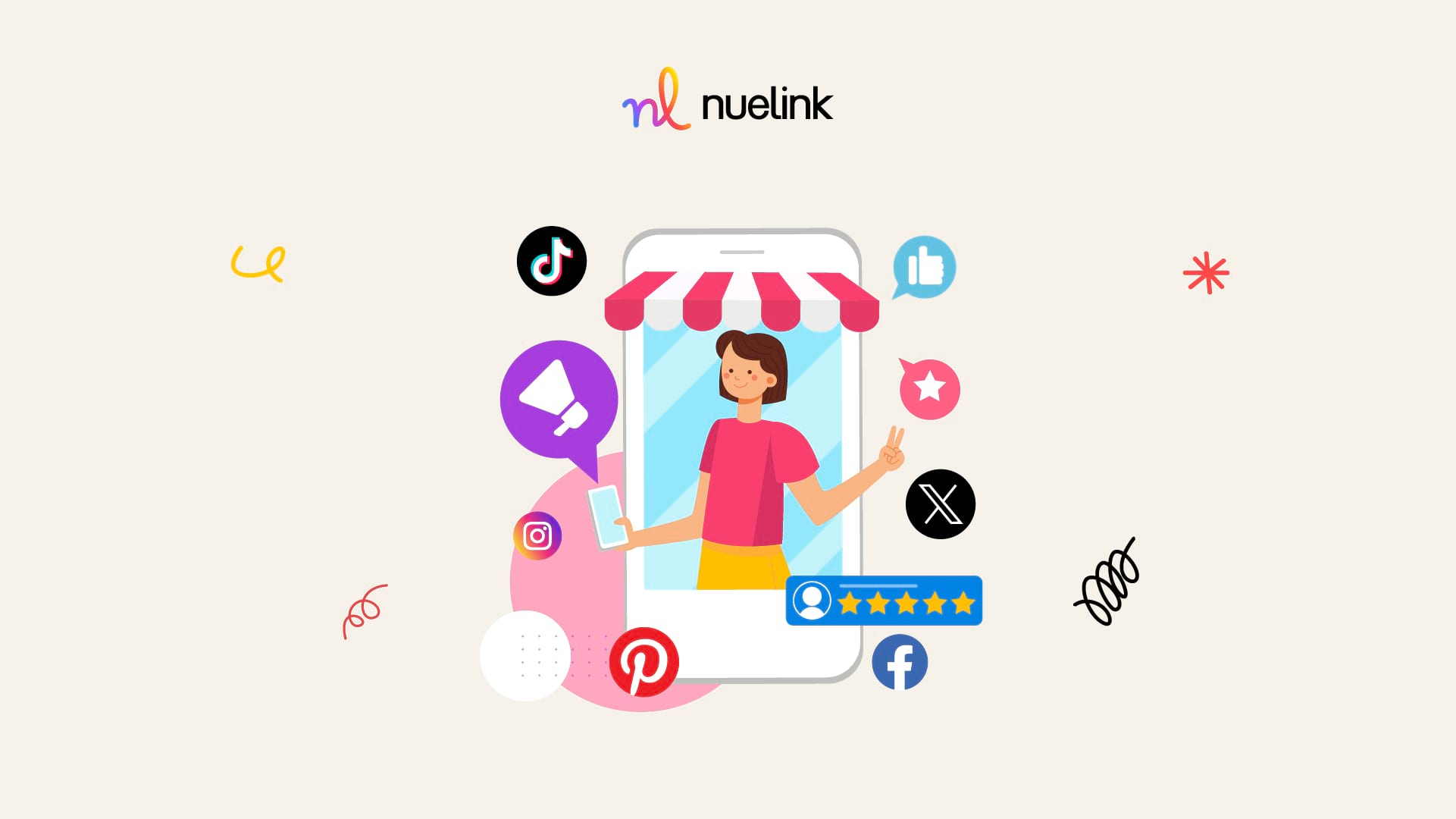Ever scrolled through your favorite social media platform and stumbled upon a stunning dress or gadget? Chances are, you've experienced social commerce in action without even realizing it.
Social commerce isn't just about buying and selling products, it's a ecosystem where social media platforms transform into bustling marketplaces where businesses can promote and sell their products in one place.
That is the appeal of social commerce, it’s just advertisement; the entire shopping experience seamlessly embedded within your social media feed. Let’s find out more about social commerce!
What Is Social Commerce?
Social commerce is the marketing and selling products and services directly through social media platforms, making it a subset of e-commerce. This strategy focuses on facilitating online transactions specifically through social media channels.
From browsing to purchasing, social commerce platforms like Facebook Marketplace and TikTok Shop facilitate every step of the buyer's journey. Gone are the days of switching between tabs and websites; you can now discover, evaluate, and buy products without ever leaving your favorite social hangout.
However, social commerce isn't merely about transactions; it's about community. Swap style tips, share product reviews, and bond over shared passions. As our social media spaces continues to evolve, so too does social commerce. It's a dynamic field that thrives on innovation, fueled by the symbiotic relationship between social media and online shopping.
Why Are Social Media Platforms Transforming into E-Commerce Hubs?
An impressive 64% of digital shoppers stumble upon brands and products through social media platforms. These platforms are transforming into comprehensive shopping hubs, minimizing interruptions in the online shopping journey.

Social media isn't just about sharing photos or catching up with friends, it's now a thriving marketplace where savvy businesses form connections to drive sales and boost their online presence.
With more eyes glued to their screens than ever before, social platforms have become the ultimate gateway to e-commerce success. This new era of social media is not just about convenience or accessibility, it's about transforming the very fabric of social interaction into a seamless shopping experience.
This shift in user behavior marks a monumental change in the way we approach online shopping. Social media platforms, once mere channels for sharing content, have evolved into bustling marketplaces where discovery meets commerce.
It's no longer enough for businesses to have a static online presence; they must actively engage with customers, create compelling content, and seamlessly integrate their products into the social media experience. This has proven quite successful for some. One streamer has made about $14 million in a week selling products on Douyin, Chinese TikTok.
What Are the Types of Social Media Commerce?

Depending on their strategies and resources, brands can delve into social commerce through various avenues. Here are the keyways to gain traction across both social media platforms and dedicated commerce sites:
1. Digital Store
These are digital retail interfaces designed to immerse consumers in a brand's product offerings. Think of it as a virtual storefront where users can browse through product catalogs and conveniently make purchases within the platform itself.
2. Conversational Commerce
Brands can engage consumers through conversational interfaces, guiding them towards making informed purchase decisions. Direct messaging and voice support are integral features to communicate and reach out to customers.
3. Livestream Commerce
This brings brands and consumers together in real-time interactions through live interfaces. Livestream Commerce offers a dynamic shopping experience. For instance, Mr. Kate, a renowned YouTuber in the DYI and home renovation sphere, recently hosted a Wayfair livestream to promote her furniture line being sold on the site.
4. AR Commerce
Augmented Reality takes shopping to the next level by allowing consumers to virtually explore and try on products. Snapchat has recently collaborated with Cartier on AR ring try-on experience. This let user live the full shopping experience from the comfort of their home.
5. AI Commerce
This is new way of social commerce but it’a gaining traction on social media. TikTok is contemplating adding a AI avatars to TikTok Shop to generate scripts for a virtual influencer to read.
How Can You Leverage Social Commerce to Increase Sales?
With millions of users scrolling through their feeds daily, social commerce presents a golden opportunity for brands to connect with their audience, showcase products, and drive conversions in a seamless and interactive manner. So, let's dive in and explore how you can unlock the full potential of social media to drive growth and success for your business.

Seamless Checkout Experience
Simplify the path to purchase by offering shoppable content that streamlines the buying process. Modern consumers crave convenience, so reducing friction points in the checkout journey is paramount. One key factor is ensuring you can accept payments online smoothly, providing customers with a fast and secure transaction experience. This has become quite an easy thing to incorporate into your strategy as more and more social media platforms add shopping tabs into their feeds, YouTube being the last addition to the group.
Incorporate the Power of User-Generated Content
Leverage user-generated content to build trust and credibility among potential customers. People trust the opinions and experiences of their peers, making UGC a potent tool for social proof. Encourage customers to share reviews, photos, and videos of your products on social media platforms. This authentic content serves as unbiased validation, reassuring prospective buyers that your products live up to their promises.
Maximize Influencer Partnerships
Collaborate with influencers to amplify your social commerce efforts and drive sales. In addition to traditional brand tagging, empower influencers to directly tag your products in their posts. This seamless integration allows followers to instantly purchase showcased items, eliminating unnecessary steps in the buyer's journey. This is a win-win-win strategy for all involved, the customer will be getting a great product, the influencer will be getting a commission on the sale, and you will have more sales and exposure.
Create Value-Driven Content
Strike a balance between promotional content and value-added material to resonate with your social media audience. While the ultimate goal is to drive sales, overly salesy content may alienate potential customers. Instead, focus on creating content that educates, entertains, or inspires your audience, showcasing the unique value proposition of your products or services.
Incorporate Live Shopping Events
Embrace the rising trend of live streaming by hosting interactive shopping events on social media platforms, need I remind you of the streamer that made $14 million in a week selling products? Yeah, I dind’t think so. Capitalize on the immersive nature of live broadcasts by showcasing products in real-time and engaging directly with viewers. Many platforms now offer the option to tag products during live streams, enabling viewers to make instant purchases.
Top Social Commerce Platforms

Understanding the pulse of popular platforms is crucial for businesses seeking to capitalize on this marketplace. Over the past few years, we've witnessed a steady rise in the number of users turning to Facebook for their purchasing needs. The numbers are mind blowing. According to recent statistics, each month, approximately 1.228 billion online shoppers make purchases on Facebook Marketplace.
With such impressive growth projections, Facebook continues to solidify its position as the undisputed leader in social commerce.
Closely trailing behind Facebook is Instagram, a platform that shares the same parent company, Meta. Mirroring Facebook's trajectory, the number of Instagram shoppers is expected to surge in the coming years. As Instagram evolves into a vibrant marketplace, businesses have a prime opportunity to tap into its visual appeal and engaged user base.
Rounding out the roster of top social commerce platforms are TikTok and Pinterest, each carving out its own niche in the digital landscape.
In 2023, around 55.5 million TikTok users in the US, accounting for 37% of the user base, made purchases through app links or directly on the platform. Projections suggest a 67% increase by 2026.
Meanwhile, Pinterest users tends to go on the app with a shopping mindset. This has made the platform huge among ecommerce sellers who want to reach an already interested audience ready ti wup out their credit cards.
So, the next time you find yourself scrolling through your favorite social media platform, keep an eye out for those hidden gems, they might just be the product of a savvy social commerce strategy in action.
But no matter what social media strategy you opt for, you NEED an equally savvy social media management and automation tool like Nuelink.







